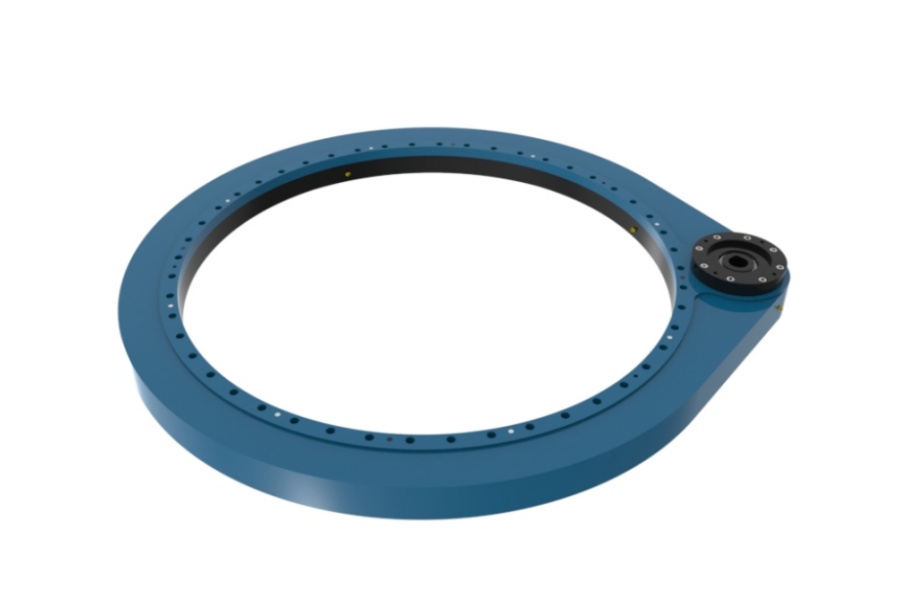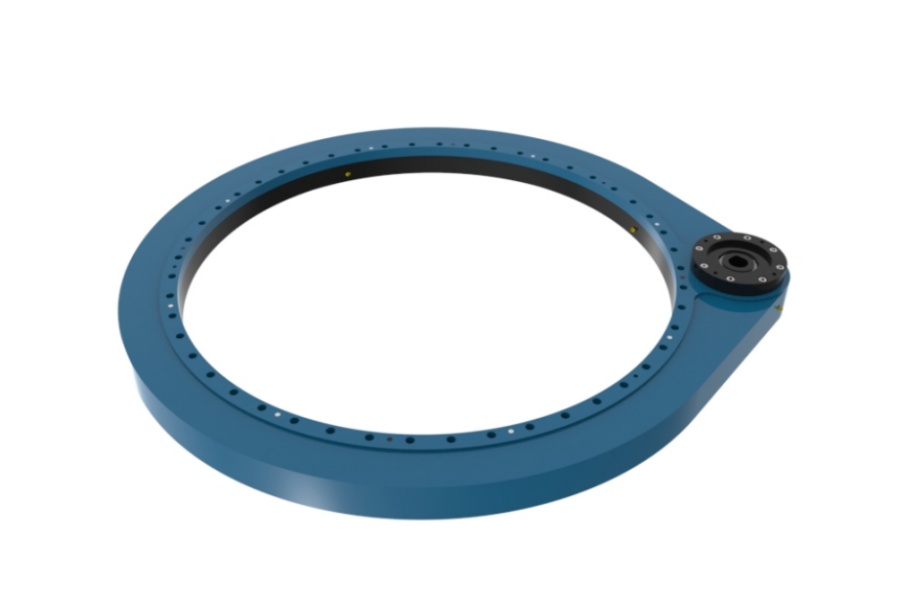
Что такое поворотный двигатель?
Что такое поворотный привод?
Аповоротный приводЭто интегрированный механический узел, обеспечивающий вращательное движение и рассчитанный на исключительно высокие комбинированные нагрузки. Его основные компоненты включают в себя поворотный подшипник, червячную передачу, прочный корпус и интегрированные системы уплотнений. Поворотный подшипник имеет внутреннее и внешнее кольца, на одном из которых снаружи или изнутри выполнены зубья шестерни. Эта шестерня точно зацепляется с червячным винтом. При вращении червячного винта, как правило, внешним двигателем, он приводит в движение шестерню, заставляя вращаться весь подшипник. Этот червячный механизм является основой функциональности поворотного привода, обеспечивая высокое одноступенчатое передаточное отношение. Это означает, что он может преобразовывать высокоскоростной входной сигнал двигателя с низким крутящим моментом в низкоскоростной выходной сигнал с высоким крутящим моментом, что делает его невероятно мощным при его компактных размерах. Важнейшим неотъемлемым преимуществом многих конструкций червячных передач является их свойство самоторможения. Благодаря особому углу червяка обратный ход часто невозможен, то есть сама нагрузка не может вызвать вращение привода, действуя таким образом как внутренний тормоз. Поворотные приводы предназначены для одновременного управления сложной комбинацией осевых, радиальных и моментных нагрузок в рамках одного автономного блока, что упрощает установку и повышает структурную целостность для производителей оригинального оборудования (OEM).

Что такое поворотный двигатель?
Термин «двигатель привода поворота» – распространённое в отрасли понятие, обозначающее не отдельный интегрированный блок, а целую систему привода, состоящую из двух основных компонентов: собственно привода поворота и двигателя, который его приводит в действие. Важно понимать, что двигатель – это внешний исполнительный механизм, обеспечивающий начальную мощность привода поворота. Двигатель не встроен в привод поворота, а прикреплён к входному валу или червячному валу привода поворота через муфту или монтажный фланец. Функция двигателя заключается в создании вращательного усилия, которое привод поворота затем уменьшает и преобразует в более мощную выходную мощность. Эти двигатели могут быть различных типов, каждый из которых обладает различными рабочими характеристиками. Часто используются электродвигатели – от стандартных двигателей переменного тока для простых применений до сложных серводвигателей для применений, требующих исключительной точности и программируемости. Гидравлические двигатели – ещё один распространённый вариант, особенно в тяжёлом мобильном оборудовании, таком как экскаваторы и краны, где они могут использовать существующую гидравлическую систему машины для обеспечения очень высокой удельной мощности и крутящего момента. Выбор типа двигателя — важнейшее инженерное решение, которое зависит от требований к точности, доступному источнику питания, крутящему моменту, скорости и условиям окружающей среды. Таким образом, «система поворотного привода» представляет собой синергетическое сочетание правильно подобранного двигателя и поворотного привода, которые вместе создают комплексное решение для управления вращением.
Характеристики поворотных приводов
Поворотные приводы обладают уникальным набором технических характеристик, делающих их предпочтительным решением для тяжелых вращательных применений. Их важнейшей особенностью является исключительная грузоподъемность. Единый компактный блок тщательно спроектирован для одновременного воздействия значительных осевых нагрузок (параллельных оси вращения), радиальных нагрузок (перпендикулярных оси) и опрокидывающих моментов (сил наклона). Такая многогранная грузоподъемность устраняет необходимость в сложных и занимающих много места специальных опорных конструкциях, которые были бы необходимы при использовании стандартных подшипников и отдельных приводных механизмов. Интегрированная червячная передача обеспечивает очень высокое передаточное отношение на одной ступени, что приводит к необычайно высокому выходному крутящему моменту. Это позволяет разработчикам систем использовать более компактные и экономичные двигатели, сохраняя при этом высокую крутящую силу, необходимую для перемещения массивных грузов.
Важнейшей характеристикой конструкции червячной передачи является её способность к самоторможению. В червячных передачах с малым углом опережения витка трение внутри зубчатой пары предотвращает обратное движение выходного вала относительно входного. Эта особенность действует как естественный тормоз, надёжно удерживая значительные грузы в неподвижном положении без необходимости использования дополнительной внешней тормозной системы, что является жизненно важным фактором безопасности во многих приложениях. Кроме того, поворотные приводы обеспечивают превосходную точность и управляемость. Редуктор обеспечивает плавное и точное позиционирование, что крайне важно в таких приложениях, как слежение за солнцем, юстировка радиолокационных антенн и робототехника. Ещё одним ключевым преимуществом является их интегрированная и модульная конструкция. Объединяя подшипник, редуктор и уплотнения в один предварительно собранный и испытанный узел, поворотные приводы значительно снижают сложность проектирования, время сборки и общую стоимость системы для производителей оригинального оборудования. Эта интеграция также повышает общую структурную жёсткость и крутильную жёсткость системы, минимизируя прогиб под нагрузкой и обеспечивая точное и повторяемое движение. Наконец, они рассчитаны на длительный срок службы, в них используются высококачественные закаленные материалы и усовершенствованные системы герметизации, обеспечивающие надежность в сложных условиях эксплуатации.
Применение поворотных приводов
Уникальное сочетание высокого крутящего момента, компактных размеров и высокой несущей способности привело к широкому внедрению поворотных приводов в самых разных отраслях. Доминирующее и быстрорастущее применение находится в секторе возобновляемой энергетики. В солнечной энергетике поворотные приводы являются основным исполнительным механизмом в системах слежения за солнцем. Они точно и медленно вращают массивные массивы фотоэлектрических панелей, следуя за движением солнца по небу, увеличивая улавливание энергии до 25-30% по сравнению со стационарными системами. Их способность к самоблокировке имеет решающее значение для предотвращения смещения панелей из-за ветровых нагрузок. Аналогичным образом, в ветроэнергетике поворотные приводы являются важнейшими компонентами как систем рыскания, так и тангажа ветряных турбин. Система рыскания использует несколько больших поворотных приводов для вращения всей гондолы, чтобы лопасти ротора были обращены к ветру, в то время как системы тангажа используют их для регулировки угла отдельных лопастей для оптимизации мощности и защиты от штормов.
Строительная промышленность и тяжелое машиностроение являются еще одним крупным сектором, зависящим от поворотных приводов. Они обеспечивают вращение на 360 градусов для верхних частей экскаваторов, поворотное движение стрел мобильных кранов и точное позиционирование стрел бетононасосов и платформ доступа. Их компактная конструкция идеально подходит для ограниченного пространства мобильной техники. Другие важные области применения включают робототехнику и промышленную автоматизацию, где они обеспечивают прочные оси вращения для сварочных роботов, паллетизаторов и сборочных машин, требующих точного позиционирования. Аэрокосмический и оборонный секторы используют их в системах позиционирования антенн радаров и спутниковой связи, где они должны обеспечивать непоколебимую точность и надежность в жестких условиях. Они также встречаются на палубных кранах и лебедках на кораблях, в медицинском оборудовании визуализации, таком как компьютерные томографы для позиционирования пациентов, и в индустрии развлечений для вращающихся сцен и тяжелых осветительных установок.
Факторы, влияющие на цену поворотного привода
Стоимость поворотного привода не является фиксированной величиной, а определяется сложным взаимодействием технических характеристик, эксплуатационных требований и коммерческих факторов. Наиболее фундаментальным фактором, определяющим стоимость, являются физические размеры и грузоподъемность устройства. Более крупные поворотные приводы, характеризующиеся большим диаметром подшипника и большими модулями зубчатых передач, требуют значительно больше сырья, более обширной механической обработки и более сложных процессов термообработки. Следовательно, привод, рассчитанный на нагрузку 100 тонн, будет на порядки дороже, чем небольшой привод, предназначенный для легких условий эксплуатации. Требуемые характеристики точности и производительности также напрямую влияют на цену. Поворотный привод, разработанный для сверхточной работы с практически нулевым люфтом в спутниковой антенне, требует более жестких производственных допусков, более качественных компонентов (например, керамических шариков) и более сложных процедур контроля качества и испытаний, чем привод для строительного экскаватора.
Выбор материалов и характеристик защиты от коррозии в значительной степени определяет конечную стоимость. Стандартный привод из углеродистой стали с простым лакокрасочным покрытием является наиболее экономичным вариантом. Однако использование расширенной защиты, такой как горячее цинкование, фирменное покрытие Geomet® или изготовление всего устройства из нержавеющей стали (например, марки 316), существенно увеличивает стоимость. Интегрированные функции и уровень настройки являются весьма изменчивыми факторами стоимости. Стандартное, готовое устройство является самым дешевым. Индивидуальные настройки, такие как специальные монтажные фланцы, встроенные высокоточные энкодеры для обратной связи по положению, специальные крепления двигателя или специальные уплотнения для обеспечения химической стойкости, требуют дополнительных инженерных и производственных усилий, что повышает цену. Объем заказа играет решающую роль благодаря экономии за счет масштаба. Крупносерийный заказ для OEM-проекта позволяет производителю амортизировать фиксированные затраты на несколько устройств, значительно снижая цену за каждый привод. И наоборот, одноразовая покупка для замены будет сравнительно дорогой. Наконец, на базовую цену может влиять динамика внешнего рынка, включая колебания стоимости сырья и условия глобальной цепочки поставок.
Поставщик поворотных приводов
Для инженеров и специалистов по закупкам, ищущих надежный источник высокопроизводительных поворотных приводов,ЛИРАДРАЙВКомпания LYRADRIVE является надежным производителем и поставщиком решений. Компания заслужила прочную репутацию благодаря инженерному совершенству, точности производства и приверженности долговечности и надежности своей продукции. LYRADRIVE предлагает обширный портфель стандартных и полностью индивидуальных решений в области поворотных приводов, разработанных для удовлетворения жестких требований различных отраслей, включая возобновляемую энергетику, строительство, обработку материалов и промышленную автоматизацию. Ключевым преимуществом LYRADRIVE является совместный подход, основанный на тесном сотрудничестве с клиентами для разработки приводных систем, идеально интегрируемых в конкретные области применения, оптимизируя их под нагрузку, скорость, условия окружающей среды и пространственные ограничения. Команда технической поддержки компании предоставляет экспертные консультации от этапа разработки концепции до установки и обслуживания, обеспечивая оптимальную производительность и долговечность. Кроме того, LYRADRIVE уделяет особое внимание строгому контролю качества, использованию высококачественных материалов и передовых технологий производства, чтобы гарантировать исключительную надежность каждого устройства в эксплуатации.



